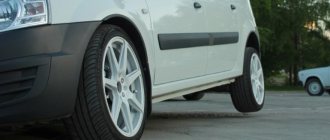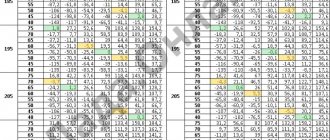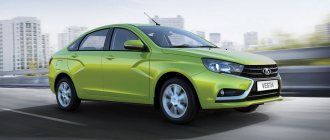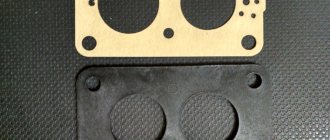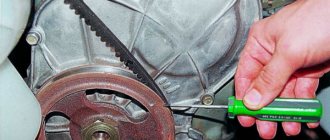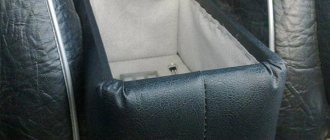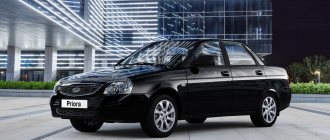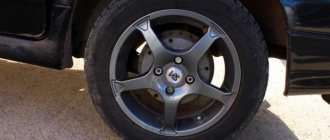Rubber provides traction between the wheels and the road and transfers engine power to the asphalt. It is important to choose the right kit for your car so that the operation of the car is as efficient as possible. Each set has such a parameter as the seasonality of the tires. Next, information will be presented about all-season tires, the features of their markings and the properties of this rubber.
In order to identify all-season tires by marking, such tires have an additional designation in the form of the letters M+S. The abbreviation Mud+Snow means that the kit provides reliable traction in difficult weather conditions. In addition, all-season tires are designated by the symbols 4S, AS or AW (4 Season, All Season or All Weather).
However, it should be understood that, in essence, all-season tires lose to winter tires at low temperatures and lag behind summer tires at high air temperatures. In fact, these tires are considered more of an off-season tire.
What is an all-season tire?
Various sets of seasonal tires are offered for the car, which differ in their characteristics and composition.
Winter tires are made of soft types of rubber, which will prevent the tire from becoming tanned. In addition, such products have a developed tread pattern and a high profile, which allows them to cling to slush and effectively drain water. The difference between summer tires is hard rubber. This tire tolerates high loads well and does not melt while driving, confidently clinging to the surface. The profile height is small, and the contact patch with the road is the most extensive. However, in low-temperature conditions it becomes dull and does not provide proper grip, which results in a long braking distance.
Finding out whether you have summer or winter tires is quite easy. Sets without any additional marks are considered summer. All-season tires are designated by the letters 4S, AS, M+S, and the Velcro or studded tires are marked with snowflake designs.
How to choose the right summer tires for your car
Only when tires are used in appropriate conditions can they provide adequate road safety. To know which summer tires are best to choose, follow the advice of the car manufacturer, take into account your individual driving style and all factors affecting the use of the products. Focus your attention on the following things:
1. Standard size.
Everything here is easy to understand. Tire size reflects the ratio of width, height and outer diameter. Usually it looks something like this: 175/55R13. In this example:
- 175 - tire width, indicated in millimeters.
- 55 - profile height as a percentage of the tire width.
- R13 is the bore diameter expressed in inches.
The seat diameter must correspond to the size of the disk; this is important to understand in order to know which summer tires to choose. R17, 16, 15, 14, etc. are all possible variants of this value. Profile width and height may vary.
You can choose wide tires - the contact patch will increase, which means there will be better traction. Please note that they are heavier, worsen the dynamics of the car, it will be more difficult to maintain control on a bad road, and fuel consumption will increase. When driving on wet asphalt, you will most likely encounter the problem of hydroplaning.
Depending on the height, summer tires can be divided into low profile (55% or less), high profile (60–75%) and full profile (80% or more). The first two options are intended for passenger cars, and the last type of tire is used for SUVs and driving on difficult country roads with many bumps and potholes.
To choose the desired profile height, you need to understand that the lower it is, the better the handling will be, but at the same time the car will react to any unevenness on the road, which means the risk of damaging the discs will increase. Therefore, low-profile summer tires are suitable for those who do not drive off smooth roads and travel at high speeds.
2. Pattern on the tread.
It has its own characteristics, which are directly related to the characteristics of the tires. There are 4 main types of patterns.
Symmetrical non-directional is the most common, considered the classic summer tire pattern, and can be chosen for city and highway driving. This tread is usually used for inexpensive tires and those that are installed at the factory. The characteristics of the tires are not affected by operating conditions and direction of travel, and you can change the wheels.
The symmetrical directional pattern on summer tires is good because it allows water to be removed from the tire contact patch as quickly as possible, and also provides excellent grip on asphalt. These tires are recommended for speed lovers and those who have to drive in wet weather. These summer tires must be installed exclusively in the direction of rotation, it is marked with an arrow on the side surface of the tires. Otherwise, the danger of driving on wet roads increases.
The asymmetrical directional and non-directional pattern is suitable for both bad weather and dry days. This is a universal option that can be found on an SUV, a family sedan, and a high-speed car. The pattern is divided into two parts: one half for dry surfaces, the other for wet grip. When installing such summer tires, pay attention to the inside/outside markings, which will help you navigate and understand where the outside is and where the outside is, respectively.
3. Speed index.
This indicator also plays an important role and is indicated in Latin letters. Each of them corresponds to the maximum possible speed that the car develops on such summer tires.
Tires with a high index have very good grip and minimal braking distance. But the price for such tires is higher, remember this when you choose summer tires. Are you going to spend 2021 without speed racing? Then you shouldn't overpay. But if you are a fan of fast driving, then it is better to stick to summer tires of category V or W.
4. Load index.
This number indicates the load that the tire can withstand at the highest speed. In other words, this is the maximum weight (including cargo, passengers and driver) on one wheel of the car.
If you often have to transport a lot of people or cargo, then you should buy tires with a high index. Check your vehicle's specifications and then refer to the table above to make the right choice.
5. Frame design.
According to this criterion, tires are divided into diagonal and radial. The first ones are very difficult to meet, since most people prefer to choose radial summer tires (letter R in the marking). These tires are suitable for all classes of cars: small cars and SUVs.
Tires are also reinforced. Then you will see the letter C (Cargo) or the combination LT (Light Truck). Heavy-duty tires are typically used for minivans, light trucks and vans, that is, for those vehicles that are much heavier than regular cars and that are used to transport cargo and passengers.
Let us repeat once again: your driving style and operating conditions determine the type of summer tires that will suit you best. We have identified the 3 most common types of riding. Roughly estimate which option is most likely for you in order to understand which summer tires to choose:
- You will spend 2019 mainly in the city and outside it, the car’s speed is moderate
. We recommend choosing tires with a profile of 60% or more, a symmetrical non-directional or asymmetrical pattern and an S speed index. - You will be driving at high speeds
. Here it is better to choose tires with a profile of 55% or less, a symmetrical directional or asymmetrical pattern, the speed index is suitable V or W. - Are you planning to drive off-road
? If you have an SUV, we recommend choosing high-profile tires with deep tread. Take another look at the load index table and choose the appropriate summer tire option. For those who have a minivan or van, special tires for commercial vehicles with the C or LT mark are suitable.
We recommend
“What do the letters on car tires mean: decoding of all indices” Read more
Parameters and characteristics of rubber
Each set has a concept of tire seasonality. Despite the fact that tires of a certain composition are labeled as all-season tires, such a set is demi-season tires. These all-season tires have a softer rubber compound. In the summer, the all-season tire will overheat and “float,” which will lead to premature wear.
In the case of ultra-low temperatures, tires will lose to their winter counterparts. Such kits work most effectively at near-zero levels, providing proper grip on cold asphalt, slush or rain. In such conditions, rubber can be used, but you should not ride on it all year round; you should wear specialized shoes for the winter or summer season.
Comparison
The main difference between winter and summer tires is the quality of the rubber alloy. Winter tires have better grip on the road surface, and also provide good vehicle handling and shorten its braking distance. Winter tires have a very interesting property: they are able to warm up while driving at very low temperatures, while they become softer and more elastic. It is the elasticity that provides excellent road grip.
Summer tires have the opposite qualities: even when driving fast and at high air temperatures, they cool down, becoming very hard and shaped. Thanks to this quality, summer tires are ideal for fast driving, but only on good roads. The difference between summer and winter tires is their expiration date. For example, summer tires are much more susceptible to wear than winter tires. Therefore, it needs to be changed approximately three times more often.
One of the most important qualities of rubber is the maximum speed at which you can ride on it. In this regard, winter tires are in many respects inferior to summer tires. Even with very high-quality road grip, it is not recommended to drive faster than 140 km/h in winter. When purchasing winter tires, you should be extremely careful, because driving safety depends on their quality. Trust only proven brands that are constantly working to improve their products by conducting numerous tests.
Pros and cons of operation
Each kit has its pros and cons.
All-season tires are no exception. Advantages:
- allow you to save money by purchasing only one set of wheels;
- feel good at zero temperatures, on wet or snowy asphalt.
Flaws:
- significantly lose to profile tires, subject to seasonality. At high temperatures the tire “floats”, and when the thermometer table is lowered, it becomes tanned. In winter the car must be on winter tires, and in summer - on summer tires.
How to choose used summer tires
Before you buy summer tires from your own hands, carefully consider all the pros and cons of such an idea. Just in case, study the prices on the car market, because often for the same money you can choose new tires from the budget segment.
If you have already decided to buy used summer tires, then you should remember a few important nuances that will help you choose a high-quality set of tires, and therefore not waste your money.
But here it is important to understand that not all drivers are well versed in the issue of choosing tires, and not everyone will openly talk to you about the shortcomings of tires. Therefore, before agreeing to purchase used tires, send them for diagnostics to a good tire shop. This procedure should be carried out with due care and preferably in daylight.
Before purchasing, check with the seller for the following details:
- Reason for sale. It is very important to clearly understand why tires are sold. They may look good, but have hidden defects. Therefore, the question of what prompted a person to choose to sell summer tires is quite appropriate and logical. But, of course, it would be pointless to ask such a question if you are dealing with entrepreneurs whose business is buying and selling used tires.
- Age. You already know that each tire has a release date stamp, but it happens that this information varies in the kit. In this case, most likely the tires were taken from different vehicles or even from different axles of the same car. Such rubber has varying degrees of wear, which means the entire set will not last long.
- History of repairs. This question is also important to ask. If the tire was not previously damaged or only had punctures in the tread, then you can send it for diagnostics to check. But if there was a side cut on the rubber, then it is better to choose other tires - these will most likely be unsuitable for use.
- Wear and cost. Professionals say that it makes no sense to buy summer tires whose wear exceeds 50%. If less than half of the resource is worn out, then compare the price of your seller and the offers for new models in the budget segment. After such a comparison, make a decision about the rationality of the purchase.
We recommend
“Why do you need wheel balancing and when to do it” Read more
Tire size
The tire size is also indicated on the sidewall of the tire. There is a European type of marking. For example, readings 205*35*R17 make it clear that the tire width is 205 mm, the profile height is 45, and the inner diameter is 17 inches. The letter r means that we are looking at shoes with radial cord weaving.
The American method is similar to the European one, only in front of the numbers there are additional letters that signal the “orientation” of the rubber (P – Passanger, LT – Light Track). There is another way to indicate the standard size, where the values are given in inches. For example, if there is a number 29*11*R18 on the side, its decoding will mean the following:
- 29 – outer diameter in inches;
- 11 – tire width;
- 18 – internal diameter.
Speed index
Another required parameter is the speed index. This is a letter designation that indicates that the car can move at a given speed for several hours. The closer the letter is to the end of the Latin alphabet, the higher this indicator. Now the most common are kits with the indexes S, T, U, HV or W, allowing speeds of 180-190-200-210-240 or 260 km/h, respectively.
Load index
Along with the speed category, tire manufacturers put down two more numbers - the maximum load index. This parameter means that the tire is capable of traveling under the specified weight on one wheel, subject to maximum pressure. The indicator is indicated in kilopascals closer to the inner radius.
The higher the indicator, the greater the load that the wheel can carry. The minimum value in the industry is 1 - 46.2 kg per wheel, and the maximum figure is 279 - 13.6 tons per cylinder.
Marking
Sometimes the marking of all-season tires can be supplemented with various icons. Among the additional symbols you can find the inscription “Retread”. The fact is that some kits need to be repaired and the compound is re-fused onto them and the tread is cut. Refurbished products carry this designation. Driving on such tires does not pose any danger, but the tire purchased by the driver will wear out a little earlier. Fortunately, the price is cheaper.
Some car tires and wheels do not fit together, having fundamental differences in design. So, if you are going to change the tires of your car yourself, it is worth remembering that the tube sets must be installed on the corresponding wheels with the designations LK, GK or RK. The symbols LB, GB or RB indicate combination with tubeless type kits (TubeLess).
Tire installation rules regulate the presence of color marks. If there is a yellow triangle icon on the sidewall, then this is the lightest part of the rubber. All you need to do is align it with the mark on the disc. The red dot indicates the hardest point and should also be aligned with the L mark on alloy wheels.
Which summer tires to choose: types of tires
Even if you contact a tire shop with a question about how to choose summer tires, you should not always count on quality advice: you may encounter inexperienced technicians, or employees will immediately begin to offer the most expensive options, because often a contract has been concluded between them and the manufacturers . When choosing summer tires, pay attention to the type of product itself.
- Road tires
Most common. They are worth choosing for driving on public roads. On the tires you will see longitudinal grooves that serve to drain water away from the contact patch. Among the advantages of tires is also low noise. All this allows you to comfortably and safely use this type of tire throughout the warm summer time.Disadvantages: not suitable for late autumn, early summer and off-road. Keep this in mind if you often travel to the countryside or if frost is expected.
- All-season tires
These tires can be chosen for the whole year. But this does not mean that they behave ideally under all conditions, both in frost and in summer heat. This only means that in moderate conditions their performance remains at a satisfactory level throughout the year. Let's look at them in more detail a little later. - Sports tires
We recommend choosing these tires for fans of high speeds and aggressive driving. They allow you to hold the car at high speeds, provide maneuverability, low noise levels and good grip. Such tires are made from a particularly hard rubber mixture, and the cord is made from harder materials. This affects ride comfort, because shocks are absorbed worse, but everything is compensated by safety on the road.The pattern on the tires is not clearly expressed - if you choose such tires, you will see only longitudinal grooves, a stiffening rib in the center and infrequent transverse grooves. Rubber will perform all its functions if the road is of ideal quality, otherwise the contact becomes worse.
The downside is that due to the shallow and simple design, water drainage worsens.
We recommend
“The wheel hits when braking: ignore it or run to the service center” Read more
Selection for SUV or crossover
We told you how to distinguish winter tires from summer tires - by the snowflake icon. However, to choose shoes for a non-trivial car, this knowledge may not be enough. When purchasing wheels for a crossover, you should imagine where the car will spend most of its time. If in the city, then standard tires with the designation AW (All Weather or Aqua - improved drainage and increased resistance to aquaplaning) are a good choice.
If the car goes beyond the definition of an SUV and you are planning trips into nature, then it is better to give preference to sets with a developed tire tread, improved lugs and increased cross-country ability. Such kits are designated by the letters AT - All Terrain.
For real off-road vehicles, special tires like Bridgestone Dueler are used, which have proven themselves in combat conditions and have high load resistance and excellent grip. This set is more expensive than the standard one, but its price is justified by its excellent qualities.
How to choose summer tires for a car: expert opinion
For many car owners, the issue of safety is very important, so they tend to choose a car with ABC, seat belts, reinforced risers and airbags. In this case, tires also play an important role. It is very important to change them according to the season. Follow these tips when choosing summer tires.
1. Do not rely entirely on the seller's opinion.
No matter how much you would like to trust the auto center employee 100%, do not make this mistake.
Not a single seller will tell you all the nuances of how to choose summer tires. He will prefer not to reveal some secrets that you should not know.
2. Pay attention to the signs on the sides of the wheels.
In particular, the following markings are important:
- Made in – will tell you where your summer tires were made.
- TRADEWERE - wear index, tells how long the tires will last.
- DOT - after this sign there is information about the place, week, month and year of manufacture of the product. A very important note!
- TEMPERATURE – coefficient of maximum temperature in the tire itself.
- Load index – permissible load on a wheel.
If it is not yet entirely clear to you how to choose summer tires for your car, then carefully study all these coefficients. The higher they are, the better.
3. Before choosing tires, study the ratings.
There is a huge amount of summer tires. Which one to choose? Focus on reviews on the Internet or ask specialists.
- Michelin
The first company I would like to mention is Michelin. Tires of this brand are very wear-resistant, the rubber provides a soft and comfortable ride. At the same time, the quality of the products itself varies somewhat and depends on the country of origin, which can be determined by the pattern on the treads. It is better to give preference to Germany, so look for the prefix “A” in the name of the rubber, for example, Energy 3A. - GoodYear
The second most popular brand is Good Year. Wear resistance here is not particularly outstanding. The tires may provide you with a soft ride, but it will most likely not last long. If you decide to buy such tires, then, again, it is better to buy summer tires from Germany, because Turkish and Slovenian ones are of low quality. - Bridgestone/Firestone
If you are seriously wondering which brand of summer tires to choose, also take a look at the models from Bridgestone/Firestone. Their wear resistance is simply incredible, and the products themselves are practically indestructible. In addition, these summer tires provide excellent handling and smooth ride. The only thing the company is not very strong in is sports tires.
These three manufacturers have a good reputation for high quality and reasonable prices.
4. It is worth choosing in advance where you want to buy summer tires.
There are several options for purchasing tires: ordering from the manufacturer, purchasing from official dealers or at a car market. It is recommended to contact authorized dealers exclusively for tires. Their prices will be slightly higher than on the Internet or in a car market, but the quality of the product will not let you down. You will always have the opportunity to study the patterns on the treads and check all the markings. This will not be possible when purchasing online.
We recommend
“How often to balance wheels with and without rims” Read more
